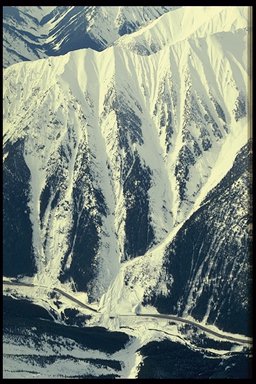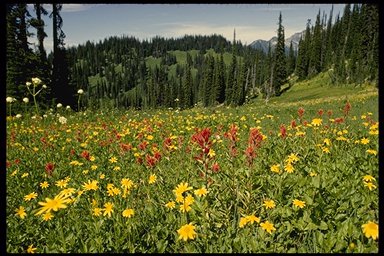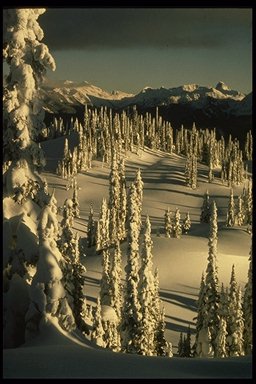
..station and Hotel are within thirty minutes' walking distance of the Illecillewaet Glacier, from which, at the left, Sir Donald (10,808 ft.) rises a naked and abrupt pyramid....
From an early CPR tourist brochure describing Glacier House amid the "Alps of North America"

A vertical world of narrow valleys and canyons squeezed between sheer mountain walls. This region has up to 23 metres of snowfall each year, triggering avalanches and spawning glaciers and icefields. In the north and central areas, the ranges are wild, jagged and spectacularly rugged, contrasting with the rounded tamer summits, forested to the top, that prevail in the south.
Hot springs are a feature of the major valleys.
VEGETATION:
This is interior rain forest country. The region has the greatest diversity of coniferous tree species in Canada, and the productivity of its forests is surpassed only by the coastal rain forests.

Above the wet forest, dense stands of Engelmann spruce, alpine fir and lodgepole pine predominate up to the alpine tundra. A brilliant palette of colour - Indian paintbrush, lupine, arnica and other species - paint the lush green alpine meadows with burning red, fiery orange, electric blue....
WILDLIFE:
Here is a region where large mammals are still plentiful and where visitors are afforded many fine opportunities for big-game viewing. Most of the mammals of the western mountains are found here. Grizzly and black bear forage on the lush vegetation of avalanche slopes; mountain goats can be seen on sheer cliffs while slightly less daring Rocky Mountain bighorn sheep graze on steep slopes. Mule deer, white-tailed deer, elk and moose share the forests with wolves and cougar and wolverine. Pikas, mantled ground squirrels, hoary marmots and lemmings forage in the alpine meadows. The mountain caribou is disappearing from the region as mature forests are cut.
STATUS OF NATIONAL PARKS
Two national parks represent this region, Glacier (1349 km2) and Mount Revelstoke (260 km2).
These parks preserve a sample of the rugged Columbia Mountains. The sharp peaks, avalanche-scarred slopes and sheets of perpetual ice and snow make these among the most rugged areas of western Canada. Over half of their area is above the tree line, a stark world of ice and rock. Heavy precipitation creates a lush forest of western red cedar and western hemlock in the valleys and feeding over 400 glaciers, some of which are visible from the highway. Plentiful snow and steep slopes combine to make these parks active avalanche areas. The many avalanche slopes provide excellent forage for both black and grizzly bears. Nakimu Cave in Glacier National Park, the second biggest cave system in Canada (next in size to Castleguard Cave in Banff National Park), is an underground fantasyland of "moon-milk", black pools and hidden waterfalls.
